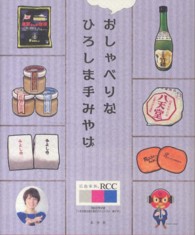- ホーム
- > 洋書
- > 英文書
- > Science / Mathematics
Full Description
As the links between health and food additives come under increasing scrutiny, there is a growing demand for food containing natural rather than synthetic additives and ingredients. Natural food additives, ingredients and flavourings reviews the legislative issues relating to natural food additives and ingredients, the range of natural food additives and ingredients, and their applications in different product sectors.After an exploration of what the term 'natural' means in the context of food ingredients, part one focuses on natural food colourings, low-calorie sweeteners and flavour enhancers, followed by a consideration of natural antioxidants and antimicrobials as food ingredients. The book goes on to review clean label starches and proteins, the application of natural hydrocolloids as well as natural aroma chemicals and flavourings from biotechnology and green chemistry. Part two considers specific applications in different products. Natural ingredients in savoury food products, baked goods and alcoholic drinks are examined, as are natural plant extracts in soft drinks and milk-based food ingredients.With is distinguished editors and expert team of international contributors, Natural food additives, ingredients and flavourings is an invaluable reference tool for all those involved in the development and production of foods with fewer synthetic additives and ingredients.
Contents
Contributor contact detailsWoodhead Publishing Series in Food Science, Technology and NutritionIntroductionChapter 1: Defining the term 'natural' in the context of food productsAbstract:1.1 Introduction1.2 The definition of 'natural' in the European Union1.3 The definition of 'natural' in the United States1.4 The International Organization of the Flavour Industry guidelines for the interpretation of 'natural'1.5 The definition of 'natural' in other countries1.6 'Natural' as applied to food additives and food1.7 ConclusionsPart I: Natural additives, ingredients and flavouringsChapter 2: Natural food and beverage colouringsAbstract:2.1 Introduction2.2 Natural food and beverage colourings currently used commercially2.3 ConclusionsChapter 3: Natural low-calorie sweetenersAbstract:3.1 Introduction3.2 Commercial bulk low-calorie sweeteners3.3 Commercial high-potency sweeteners3.4 Potential future sweeteners3.5 Other sweeteners3.6 Conclusions3.9 Appendix: abbreviationsChapter 4: Natural food and beverage flavour enhancerAbstract:4.1 Introduction4.2 Savoury flavour enhancement: umami tastants and ingredients rich in umami compounds4.3 Umami taste modifiers and taste enhancing peptides4.4 Maillard-derived taste enhancers4.5 Interactions in the perception of non-volatile tastants and volatile or semi-volatile flavour compounds4.6 Future trendsChapter 5: Natural antioxidants as food and beverage ingredientsAbstract:5.1 Introduction5.2 Natural antioxidants: background5.3 Natural antioxidants: properties, manufacture and applications5.4 Future trendsChapter 6: Natural antimicrobials as additives and ingredients for the preservation of foods and beveragesAbstract:6.1 Introduction6.2 Natural antimicrobials derived from microorganisms6.3 Natural antimicrobials derived from animals6.4 Natural antimicrobials derived from plants6.5 Essential oils6.6 Enzyme-released antimicrobial agents6.7 Other enzymes6.8 Future trendsChapter 7: Native, modified and clean label starches in foods and beveragesAbstract:7.1 Introduction7.2 Manufacture of starch in plants7.3 Starch composition7.4 Amylose and amylopectin7.5 Starch: extraction and manufacture7.6 Starches from different sources7.7 Modification of starches7.8 Clean label starches7.9 Conclusions and future trends7.10 Sources of further information and adviceChapter 8: The application of natural hydrocolloids to foods and beveragesAbstract:8.1 Introduction8.2 The main types of hydrocolloids used in foods and beverages8.3 Natural hydrocolloids: their manufacture, properties and applications8.4 Future trends8.5 Sources of further information and adviceChapter 9: Proteins as clean label ingredients in foods and beveragesAbstract:9.1 Introduction9.2 The range of clean label proteins used as ingredients in foods and beverages9.3 Examples of applications of proteins in foods and beverages9.4 Future trendsChapter 10: Natural aroma chemicals for use in foods and beveragesAbstract:10.1 Natural aroma chemicals and the origins of organic chemistry10.2 Naturals in the twenty-first century10.3 Quality control and natural aroma chemicals10.4 Natural aroma chemicals by direct isolation10.5 Natural aroma chemicals by traditional food preparation processes: cooking chemistry10.6 Natural aroma chemicals by biotechnology10.7 Assessing the natural status of aroma chemicals10.8 Future trendsChapter 11: Natural flavourings from biotechnology for foods and beveragesAbstract:11.1 Introduction11.2 Production of natural flavors by de novo synthesis11.3 Production of natural flavors by biotransformation11.4 ConclusionsChapter 12: Natural flavourings from green chemistry for foods and beveragesAbstract:12.1 Introduction12.2 Green extraction techniques12.3 Green synthesis techniques12.4 Future perspectivesPart II: Applications in different productsChapter 13: Applications of natural ingredients in savoury food productsAbstract:13.1 Introduction13.2 Natural ingredients for savoury foods13.3 Formulating savoury products using natural ingredients13.4 Crisp and snack seasonings13.5 Liquid savoury products13.6 Coating systems for savoury products13.7 Reduction, replacement and removal of particular ingredients13.8 Future trends13.9 Sources of further information and adviceChapter 14: Applications of natural ingredients in baked goodsAbstract:14.1 Introduction14.2 Evaluation of the 'naturalness' of selected bakery ingredients14.3 Issues to consider when using natural ingredients in baked goods14.4 Future trends14.5 AcknowledgementsChapter 15: Applications of natural plant extracts in soft drinksAbstract:15.1 Introduction15.2 Fruit juices and oils produced by expression15.3 Natural additives for soft drinks produced by distillation15.4 Natural extracts produced by solvent extraction15.5 Usage amounts and label declarations15.6 Water as an ingredient in soft drinks 15.6.1 Introduction15.7 Future trendsChapter 16: Applications of natural ingredients in alcoholic drinksAbstract:16.1 Introduction16.2 Flavouring agents and colorants16.3 Process aids16.4 Yeasts, bacteria and fermentation aids16.5 Water16.6 Future trends16.7 Sources of further information and adviceChapter 17: Dairy products and milk-based food ingredientsAbstract:17.1 Introduction17.2 Milk as a source of food17.3 Dairy products and food additives, ingredients and flavourings17.4 Milk as a source of food ingredients and flavourings17.5 Future trends17.6 Acknowledgements17.7 Sources of further information and adviceIndex







